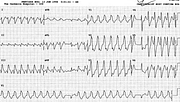No Response to DC Cardioversion
Report:
Probable atrial flutter or fibrillation
Non-sustained monomorphic ventricular tachycardia 160/min
Inferior infarction ?age
Comment:
The patient was one of those surgical disasters that attract multiple medical consultations in the hope of explaining why things went wrong. Interestingly enough, one of the consultants was a Cardiologist called in by the surgeon while I was away. He and the duty Intensivist shocked the patient three times before declaring him resistant to countershocks!
One can see at once why electricity did not work: the patient was cardioverting himself all the time, only to relapse after a few seconds. He had been at it for days (below, Fig 225a), on top of the original sinus rhythm, long before he had to come to ICU.
The QR complexes in the inferior leads are due to a known (remote) inferior infarction. Their morphology is diagnostic of infarction even in VEBs and VT146. The supraventricular beats show no reciprocal changes, but the ventricular ectopic ones do. The infarction looks acute or recent on these ECG, perhaps exaggerated by the tachycardia.
The patient was put on amiodarone infusion and the VT subsided into bigeminy (in probable flutter) and then isolated VEBs in sinus rhythm with SVEBs (below, Fig 225b).
If you have any suggestions for or feedback on this report, please let us know.
Hi, can we chat about some terms and conditions?
The library and it's records are licensed under the Creative Commons Attribution 4.0 International license.
You are free to:
- Share — copy and redistribute the material in any medium or format for any purpose, even commercially.
- Adapt — remix, transform, and build upon the material for any purpose, even commercially.
- The licensor cannot revoke these freedoms as long as you follow the license terms.
Under the following terms:
- Attribution — You must give appropriate credit , provide a link to the license, and indicate if changes were made . You may do so in any reasonable manner, but not in any way that suggests the licensor endorses you or your use.
- No additional restrictions — You may not apply legal terms or technological measures that legally restrict others from doing anything the license permits.
By clicking agree below, you are agreeing to adhere to CC BY 4.0.


